If you're new here, you may want to subscribe to my RSS feed. Thanks for visiting!
by Patrice Lewis
As concerns about interruptions in the supply chain due to the pandemic hit the news, Victory Gardens are once again becoming popular. This is great news!
Building a garden infrastructure can be expensive, especially for those in urban or suburban environments where open space is limited. If you start pricing boards for building raised beds, for example, you’re likely to come away shaking your head in disbelief.
Surely there is some inexpensive way to establish a viable garden?
There is. I’m here to tell you about an excellent free resource for raised bed gardening which nearly everyone ignores because of a powerful but incorrect urban myth about the dangers. I refer to gardening in tires. Yes, tires. Car tires, truck tires, tractor tires…you name it. And, these can be used tires!
Why Tires?
When we moved to our rural homestead seventeen years ago, we thought it would be a simple matter to establish a garden. After all, how hard could it be? Plow, plant, water, and voilà: Food security.
We were wrong. We hadn’t factored in the heavy clay soil, pests ranging from deer to voles, and especially the tough prairie grasses. Every year we found our vegetables overwhelmed with weeds and baked into hard clay. No one who hasn’t experienced prairie grasses has any idea how pervasive, stubborn, and overwhelming those grasses can be. Since we didn’t have a tractor, our attempt to keep a half-acre garden weed-free was impossible.
For nine years, we struggled to plant in the ground, and for nine years, we failed. We tilled in compost and mulched. We pulled weeds, and we pulled more weeds. When it looked like we might succeed with a modest patch of beans or peas, the deer would invade, or the voles would dig things up (or an early frost would hit), and that would be the end of that.
RELATED: How to Grow a Survival Garden (and What to Do if it Fails)
Finally, we decided we had to look outside the box. We stepped back, identified our problems, and then addressed them one by one.
After some experimentation, here’s what we did. We paved the garden area with old billboard tarps (to control the weeds), anchored them with gravel (to hide the tarps as well as provide drainage), and brought in tires ranging in size from truck to tractor. We filled the tires with a mixture of topsoil, compost, and sand. We arranged a drip irrigation system throughout. As a result of these efforts, we went from zero to nearly self-sufficient in fruits and vegetables inside of two years.
The combination of tractor tires, tarps, gravel, and eight-foot fences (against deer) pretty much solved our gardening issues. True, we don’t have a lovely “traditional” vegetable garden with neat rows of perfect vegetables. Instead, we have rows of massive tractor tires blooming with lush vegetation. We even planted our fruit trees in tires.
And no, we aren’t poisoning ourselves.
The Power of an Urban Myth
But aren’t tires toxic? No.
This myth sprang up from a single article in the July/August 1997 issue of Organic Gardening magazine. The article cited two researchers: One in Australia and the other with the USDA.
Someone with the now-defunct website TireCrafting got hold of the Australian researcher, who confirmed the Organic Gardening article misquoted him. He never claimed tires would poison food plants; he merely observed that he knew of only one toxin in the rubber of tires, namely zinc. Zinc, which is leached from burned tires, ground-up tires, and the tire dust washed or blown from highways, is toxic to some plants. In tires, however, zinc is bonded and will not leach.
To confirm this information, I contacted the USDA representative, now retired. He kindly sent me no fewer than eleven publications he authored, attesting that zinc – when bound up in tires – is inert and will not leach. It’s only when tires are ground up that zinc in potentially toxic quantities are released. I have no intention of grinding up any tires in our garden, so I’m not worried about hazards.
I hope this information lays to rest any concerns about gardening in tires.
Raised Beds vs. Raised Containers
A distinction should be made between raised beds – which are open to the ground – and raised containers, which have closed bottoms (though still permitting drainage). Both kinds of beds provide similar benefits, though raised containers can be used on patios or other areas with no ground contact.
Our tire garden consists of raised containers since the tires are not in direct contact with the ground. This makes weed control far easier.
RELATED: 10 Ways to Sow Revolution in Your Back Yard
Building a Garden
So how do you grow in tires? Here are a few things we learned:
- A weed-control base is necessary, which still allows for drainage; otherwise, weeds and other pests (including voles) merely come up through the tires. The weed control has to be permanent, not temporary (such as newspapers or cardboard). We learned vinyl tarps work splendidly. We know others who use corrugated sheet metal as a base.
- Drainage is essential. If your tires are on a weed-control base – even concrete or another flat, impervious surface – be sure to provide a means for water to drain. Gravel is ideal.
- If your climate is hot, you can paint the tires white or another light, reflective color. In our northern region, the black tires increase heat absorption, extending the growing season a bit.
- Tires should have at least one sidewall cut out. We use a Sawzall for this purpose. Cutting out one sidewall allows a greater growing area. We keep the other sidewall intact and facing the ground, which helps keep the tire’s shape. Some people prefer to cut out both sidewalls, which allows the tire to be turned inside-out and painted.
- Size does not matter. Backyard suburban gardeners may want to stick with truck or car tires, which are easier to move and can be stacked in many attractive variations. With our large garden and rural location, tractor tires work for us. However because of the sheer weight and size of tractor tires, I don’t recommend using them unless you are certain their placement is permanent.
- Tires are particularly suited to drip irrigation since drip hoses can be coiled neatly in a circle. This saves both water and work.
- Weeding is easier. I can weed just as many tires as I have time or energy for, plus when I sit on a crate the weeds are at a more convenient level (knee-high instead of foot-level). I don’t grow fatigued from squatting or kneeling for long hours.
- The soil is never compacted and remains friable, especially since I add compost about every other year and pitchfork it in to feed the soil. The beds can also be easily mulched.
If you’re trying to come up with a frugal, economical way to garden and take control of a portion of your food supply, it’s time to think outside the box. Forget the urban myths and embrace a free, durable resource. Consider gardening in tires.
RELATED: Dirt Cheap-The Best Frugal Gardens on the Internet
About Patrice
Patrice Lewis is pleased to announce the availability of the complete collection of 52 Country Living Series ebooklets, representing over 17 years of homesteading experience. Subjects include preparedness, gardening, frugality, rural skills, food preservation, and more. Click this link for details.

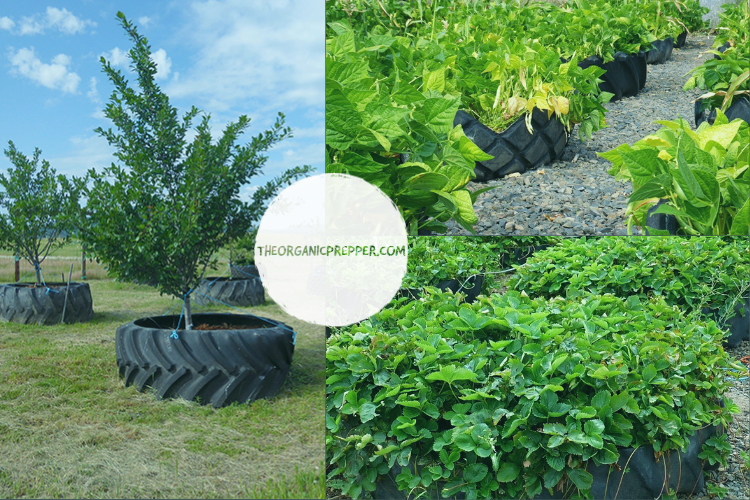
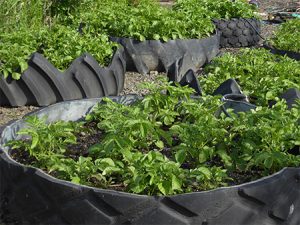

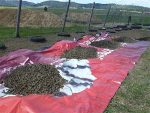
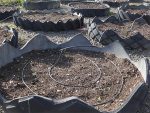
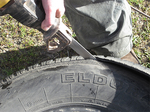











4 Responses
Electric fence is an inexpensive way to keep deer out of a garden or orchard. Make sure the charger is off (say that 3 times). Using cheap creamy peanut butter, smear some on a wire that is waist high about every 6 to 8 feet. Turn on the charger. The deer smell the peanut butter and try a sample. They soon learn to associate the smell of peanut butter with PAIN. Reapply peanut butter after heavy rain.
This was very effective in protecting 200 apple trees in my orchard.
Humm, I wold suggest anyone interesting in this type gardening to do their due diligence. Since the study in 1997, more research has found additional toxicity that can potentially be found in tires – it’s a lot more than the zinc mentioned in this article. You may have no plans to grind or burn the tires on your property, however who’s to say what may happen in the future. It would be just as easy to put down the tarp/gravel and build raised beds, imagine there are many other items that could be used as containers besides tires. This way there are NO worries whether your containers are potentially toxic or not.
I would use the big one but I’m still flipping it and using them to work out LOL
They are also part of my roadblocker plan along with my oil changes.
I only grind tires to put in pipes for bullet traps.
I usually lurk and don’t post often, but here are a few of the different containers I’ve had success with and been able to source for free/cheap.
-Food Grade Buckets
All you have to do is drill a few drainage holes, they don’t last forever(average in N. Central FL, about 2 years). I used to get them free from the Publix deli and bakery. (These can also be used to build vermicomposters, fermentation chambers, store rice/beans/sugar/salt etc. once stored properly in mylar).
– Concrete Cinderblocks
These I have used as the walls for raised beds, and they are also really nice to grow onions/scallions/garlic/herbs as a barrier crop along the outside to slow down insect invasions(An annual problem in the gunshine state). You can get them free by checking Craigslist/market place etc. for free haul away, but brand new will set you back around $1.50 each
-Empty Pet Food/Litter Bags
These only require a few holes for drainage in the bottom, and are wonderful for growing potatoes. I like to roll them almost all the way down, put in a potatoe with good eyes, and cover with grass clippings weekly. This helps to compost grass clippings and grow food at the same time. They only last a season, sometimes two, but are good while they last. Even if you don’t have pets, talk to friends and neighbors and you’ll have more than you can plant in a couple months. These are also made from Food Grade materials, and so shouldn’t be toxic as they break down.
-Empty Cans
These are most useful as starter pots. I use a nail and poke one hole through the bottom. **CAUTION** These can definitely cut the hell out of you if not handled carefully during planting/removal.
That’s all from me today. Stay well, be prepared, love your neighbor, and if your the praying type, send one up for the U.S.A., she could really use some help from above about now.